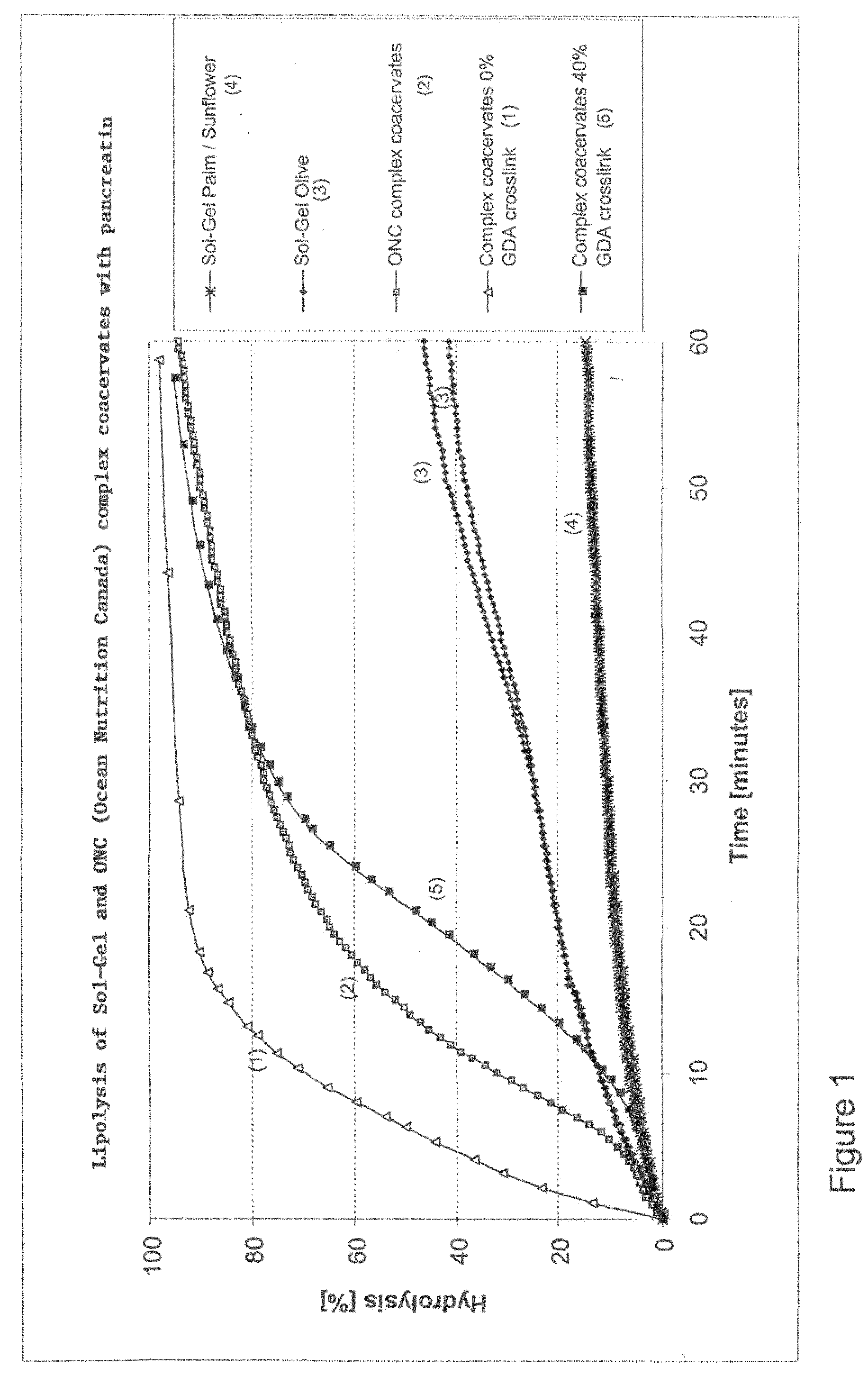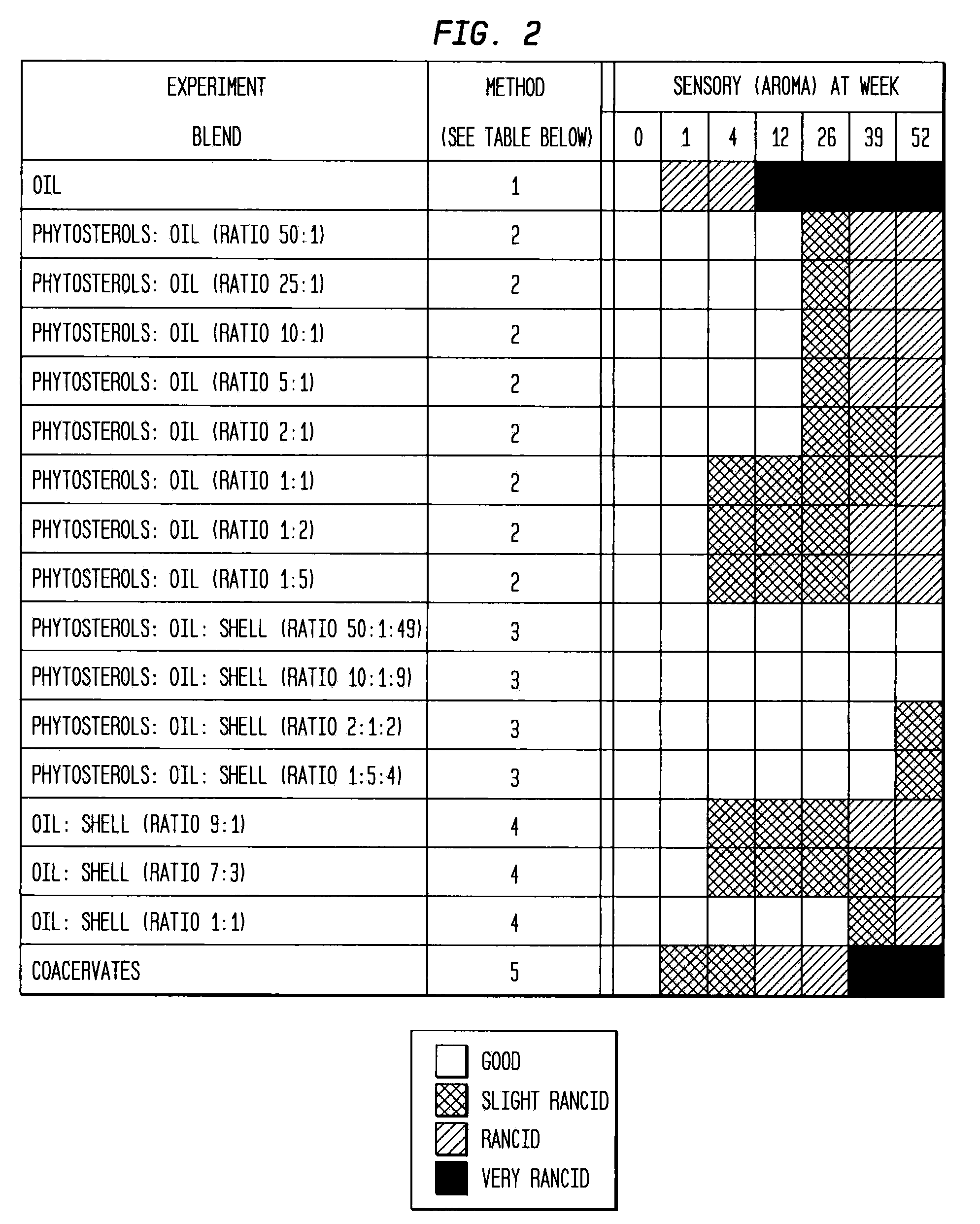Encapsulate and Food Containing Same
a technology which is applied in the field of encapsulated food and food containing same, can solve the problems of difficult control of the process and the production of monoliths, the inability to easily add, and the tendency to oxidize and produce an off-taste after a time, so as to increase the satiety effect and the effect of high oxidation ra
- Summary
- Abstract
- Description
- Claims
- Application Information
AI Technical Summary
Benefits of technology
Problems solved by technology
Method used
Image
Examples
example 1
Encapsulation of Canola Oil
[0145]
IngredientWeight [g]Canola oil100Tetraethoxysilane250HCl (pH = 0.1)20NaOH (pH = 11)6
[0146]Canola oil was mixed with the TEOS (Dynasylan A™ from Degussa). The mixture was at 64° F., mixed at 10,000 rpm for three minutes. Then the hydrochloric acid was added until the temperature rose to 112° F. The sodium hydroxide solution was then slowly added. The temperature started rising and when it reached 120° F. the speed was rapidly reduced to 1000 rpm while temperature kept rising to 148° F. The exothermic reaction lasted about 20 seconds. During the reaction time ethanol was collected in a trap cooled with a mixture of dry ice and isopropyl alcohol (e.g., ˜15° F.). The speed was reduced to about 400 rpm. When the product cooled off, a solution of Ethanol 95% was added to wash off some of the sodium chloride formed.
[0147]The precipitated product was then placed in a vacuum cell at room temperature with a cold trap (˜15° F.) that retained the ethanol and vol...
example 2
[0148]The “center” of a coated bar is formed from the following components:
ComponentWt % of CenterProtein25Sugar8Rice cereal16Soy protein6Vitamin / mineral4mix (includingmicroencapsulatedcupric gluconateexWright Group)Sodium chloride0.5Corn syrup28.5Molasses4Peanut butter4Encapsulated product4(made by procedureof Example 1)
[0149]The liquid components are mixed, after which the dry ingredients are added and mixed until the product is substantially homogeneous. The encapsulated product of Example 1 is added with the dry components. The mixture is then fed into a die and extruded at room temperature and atmospheric pressure. Upon extrusion, the bar is cut into individual serving sizes which are then coated with a chocolate confectioner's compound coating. The bar is packaged and kept at 85° F. for 12 weeks, after which it is opened and eaten. No off taste is detected. Each week of successful storage at 85 oF is believed to equate to one month of successful storage at ambient temperature....
example 3 (
EXAMPLE 3(b)
Encapsulation of a 50:50 Blend of Palm Oil and Sunflower Oil
[0153]
IngredientWeight [g]Palm oil183.46Sunflower oil185.96OSAN starch5.09Isomaltulose1.61H2O9.79Tetraethoxysilane430.31HCl (pH = 0.1)82.14NaOH (pH = 11)104.28
[0154]The thick aqueous phase A containing Isomaltulose, OSAN starch, and water was made by mixing the ingredients at 4000 rpm at about 95° F. OSAN starch is starch reacted with octenylsuccinic anhydride. The oil phase B containing palm oil and sunflower oil was blended at 95° F. The aqueous solution A and the oil phase B were mixed together at 10,000 rpm to form an emulsion C. The emulsion C was then mixed with the TEOS (Dynasylan A™ from Degussa) at 10,000 rpm for three minutes. The hydrochloric acid was added until the temperature rose to 110° F. The sodium hydroxide solution was then slowly added. The temperature started rising quickly; when it reached 122° F. the speed was rapidly reduced to 1000 rpm while temperature kept rising to 148° F. The exothe...
PUM
 Login to View More
Login to View More Abstract
Description
Claims
Application Information
 Login to View More
Login to View More - R&D
- Intellectual Property
- Life Sciences
- Materials
- Tech Scout
- Unparalleled Data Quality
- Higher Quality Content
- 60% Fewer Hallucinations
Browse by: Latest US Patents, China's latest patents, Technical Efficacy Thesaurus, Application Domain, Technology Topic, Popular Technical Reports.
© 2025 PatSnap. All rights reserved.Legal|Privacy policy|Modern Slavery Act Transparency Statement|Sitemap|About US| Contact US: help@patsnap.com


